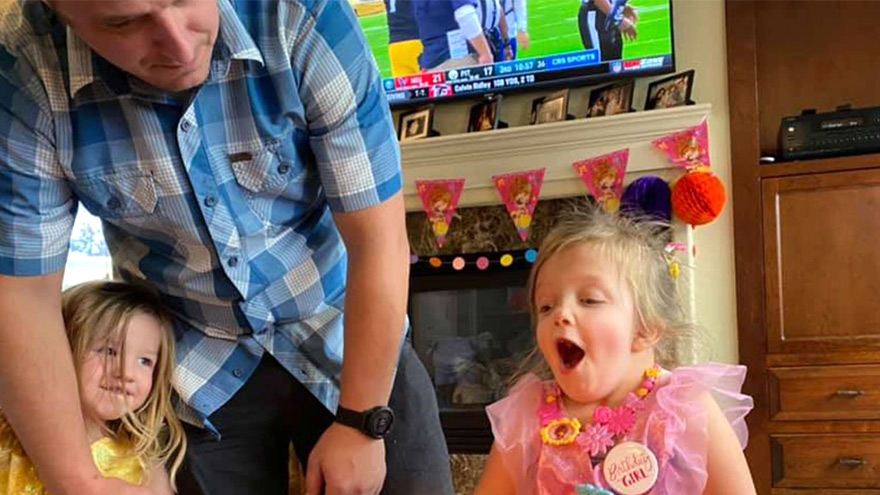Search
-
Human Trafficking Happens in Nevada
Each month an average of 5,016 individuals are sold for sex in Nevada. Frequently the victims of human trafficking are women and children. That’s why Renown, along with other community groups, is leading efforts to help victims. Specifically identifying them and connecting them to the support services they need. The purpose is to restore their mental and physical health give them hope for a better life. Supporting Our Community Our goal is to identify victims, providing compassionate care for the complex needs of this vulnerable population. By building partnerships with key agencies and advocates in the community and creating policies around human trafficking, we also aim to transition victims safely to community-based services. Along with training, Renown healthcare workers are armed with pocket guides reminding them how to support human trafficking victims. To provide awareness about this crisis, Renown has implemented four key initiatives: Educate health care providers Execute policies and procedures to identify victims Build partnerships with local law enforcement, emergency services and local advocates Connect victims to crucial community resources Human Trafficking: How You Can Help Awaken acts to transform our community with the ultimate goal of ending commercial sexual exploitation. In 2020, Awaken worked with 173 women and children. Awaken’s programs include a drop-in center, an 18 to 24 month transitional housing program, an educational center for trafficked youth, rental assistance, recovery groups, therapy, tutoring, case management, mentorship, safety, and community. National Human Trafficking Hotline: 1-888-373-7888 Local Emergency: 911 Did You Know?
-
What Is the Role of a Child Life Specialist?
What is the role of the child life specialist? Here are common questions and answers about how these special individuals give both parents and kids peace of mind. Let’s face it: A hospital can be an intimidating place for just about anyone. But add in being a small human with very little worldly experience — aka a child — and it’s easy to imagine how overwhelming a hospital visit can be. Enter the role of the child life specialist. Liz Winkler, a child life specialist with Renown Children’s Hospital, explains how a Renown program puts young patients and their families at ease. What does a child life specialist do? Child life specialists help young patients develop ways to cope with the anxiety, fear and separation that often accompany the hospital experience. They give special consideration to each child’s family, culture and stage of development. As professionals trained to work with children in medical settings, specialists hold a bachelor’s or master’s degree in the areas of child life, child development and special education or recreational therapy. Our child life specialists are also professionally certified and affiliated with the national Child Life Council. Child life specialists also offer tours of Renown Children’s Hospital for families whose children are scheduled to have surgery. Child life supports children and families by: Helping children cope with anxiety, fear, separation and adjustment Making doctors, needles and tests a little less scary Providing art, music and pet therapy Organizing activities Addressing your concerns Telling you what to expect Creating a therapeutic and medical plan Offering a hand to hold What else is available at the Children’s Hospital that helps ease some of the stress of a hospital visit? Whether it’s seeing a pediatrician, getting a sports physical or looking for advice, our care is centered on supporting and nurturing patients and families at our many locations. We have kid-friendly environments to help ease some of the stress of a hospital visit. These include colorful exam rooms, kid-friendly waiting and common areas, and medical equipment designed especially for children. Our children’s ER is open 24 hours a day, seven days a week. So parents and caregivers have access to emergency care tailored to little ones — anytime, day or night. We have several pediatric specialists on the Renown team in areas including diabetes, emergency medicine, neurology, pulmonology, blood diseases and cancer. How can parents start to ease their children’s mind when they know a hospital visit is in the future? As with many things in life, good preparation can help kids feel less anxious about the experience and even get through recovery faster. It’s important to provide information at your child’s level of understanding, while correcting any misunderstandings, and helping to eliminate fears and feelings of guilt. If you’re anxious and nervous, your child may reflect these feelings and behaviors. So make sure you educate yourself, feel comfortable with the process, and get your questions answered.
Read More About What Is the Role of a Child Life Specialist?
-
Recipes Healthy Flourless Sweet Potato Brownies
Rich, dark and super chocolaty, these sweet potato brownies are perfect for those following a paleo, vegan, gluten-free or dairy-free lifestyle.
Read More About Recipes Healthy Flourless Sweet Potato Brownies
-
If You're a Soon-To-Be-Dad, We've Got Tips for You
“You’re gonna be a dad!” Whether you’ve been waiting years to hear those words or still think you’re too much of a kid to have a kid, the reality of impending fatherhood can be terrifying for any first-time, soon-to-be-dad. But not to worry, Best Medicine has some timely tips to help calm those bundle-of-joy fears and help you rock your new role as a brand-new, baby daddy. Winter is Where Babies Come From Fact: More babies are born in September than any other month, with spill over (and spit-up) into October. Subtract ten months for the typical 40-week, bun-in-the-oven baking time and early winter stands out as the top baby-making part of the year. Is it the cozy nights before a fire as people avoid the snowman-friendly temperatures outside? Possibly. There could be any number of reasons, both seasonal and otherwise, for what will eventually arrive in the fall and immediately steal your heart — and untold hours of your sleep. Though moms carry most of the baby burden traditionally (and literally for three trimesters), that’s no excuse for the soon-to-be-dad not to step up to the plate and take a swing at being the best partner and father on the planet. Below is a list of tips and resources to help you do just that. So read on, daddy-o. Tip #1: Don’t Freak Out Ok, you’re probably going to freak out even if we tell you not to. But once you calm down, consider this: human beings have been having babies for millions of years, and many of those soon-to-be-dads had it much tougher than we do today. And guess what? The human race is still going strong. Those first moms and dads did a good job — and you will too, with a little help. Tip #2: Take a Class Knowledge is power. In this case, it's diaper-changing, swaddle-wrapping, 2 a.m.-feeding power. And for you and your partner, taking a parenting class or two should be a no-brainer. You'll both learn what to expect and prepare for as you support each other and bond with your baby even before he or she arrives. Tip #3: Learn From Other Dads If the thought of sitting in a room full of full-bellied women and their partners makes you uncomfortable, you may opt to stick with bros for your lesson plan. Dad-only classes and soon-to-be-dad support groups — taught and led by seasoned fathers with tales to tell and words of wisdom to share — are available online and in cities and communities around the country. Dad-focused sites also offer advice for new and still-learning proud papas. Here are a few options to check out: Boot Camp for New Dads City Dads Group Wilderdad.com Fatherly.com Fathers.com Tip #4: Babies are Required Reading Haven't read a good book lately? Well, if you're expecting a baby, now is the time to flip through a few pages that could make your life a whole lot easier in a few months. There's no such thing as being too-well-read when it comes to your fast-approaching, adorable little poop machine. The least you can do is read a book or two, or seven. We're Pregnant! The First Time Dad's Pregnancy Handbook From Dude to Dad: The Diaper Dude Guide to Pregnancy We're Pregnant! The First Time Dad's Pregnancy Handbook What to Expect When Your Wife Is Expanding Be Prepared: A Practical Handbook for New Dads The New Dad's Survival Guide: Man-to-Man Advice for First-Time Fathers What to Expect When You're Expecting Tip #5: Be a Prepared Soon-To-Be-Dad Tips 1 through 4 are meant to help alleviate some of your jittery, new-dad anxiety. And we hope they do just that. But if you really want to hold that "Best Dad Ever" coffee mug starting on day one, there are also some practical things you can do to prepare. Check these items off your list now to make life with baby more baby-, mommy- and daddy-friendly from the get-go. Buy a baby/child car seat. Three out of four car seats are installed incorrectly. Protect your children by ensuring they are riding in a properly secured and age-appropriate car seat. Renown Children’s Hospital Car Seat Station is staffed by certified technicians who provide child vehicle safety restraint education, inspection and installation. Set up the baby's nursery early, including furniture Stock up on diapers and baby supplies Cook and freeze 2 weeks of food for nights when no one wants to cook Research family healthcare Agree upon a shared diaper-changing/feeding schedule Ask about paternity leave from work Get bills and finances up-to-date or pre-pay to avoid late charges Give the home a thorough cleaning before the baby arrives
Read More About If You're a Soon-To-Be-Dad, We've Got Tips for You
-
What to Know Before You Try Intermittent Fasting
As many people search for diets to try to achieve weight loss resolutions, Kim Colegrove, Renown Dietary Educator, has all you need to know about one of the trendiest diets – intermittent fasting. What is intermittent fasting? Intermittent fasting is an eating pattern that switches between periods of fasting with no food or very restricted caloric intake, and periods of unrestricted eating. The diet has come into popularity as a way to help people lose weight without restricting what they eat, just when they eat. How does it work? The rationale behind intermittent fasting is that the pattern of eating promotes weight loss due to hormonal changes – namely, the decrease in insulin levels – as well as effects on your gut and overall decreased energy consumption. There are various schedules, including alternate-day fasting and time-restricted feeding. For example, one popular method involves restricting your eating period to eight hours per day and then fasting for the remaining 16 hours. Another requires fasting for 24 hours once or twice per week. What should people consider before they try intermittent fasting? Some people have found success in losing weight with intermittent fasting. However, it’s important to note that it’s not a diet that necessarily promotes sustainable habits and lifestyle changes. There’s also not enough research conducted that shows its lasting impact on health, weight, or metabolic improvement. For most, an intermittent fasting diet is just that – a diet. A person will likely lose weight because they consume fewer calories, but keeping the pounds off is an aspect of healthy weight loss that requires a permanent lifestyle change. Who should NOT try intermittent fasting? Intermittent fasting is not for everyone and it can pose a health risk to women who are pregnant or breastfeeding, people with diabetes, and children and adolescents in an active growth stage. Also, it would not be appropriate for those with a history of eating disorders, as well as people with certain health conditions that require them to eat every few hours. You should always talk to your doctor before beginning a restrictive diet such as this, especially if you have a chronic health condition or are taking certain medications.
Read More About What to Know Before You Try Intermittent Fasting
-
Bone Fractures in Children Honest Expert Advice
Michael Elliott, MD, head of the Department of Pediatric Orthopedics and Scoliosis, answers some common questions about bone fractures. Is there a difference between broken bones and fractures? No, these are two different names for the same injury. Of course the common term is a broken bone. Using either name will describe your concerns. Medical personnel typically describe a broken bone as a fracture to a specific bone. For example, a broken wrist is also a fractured distal radius. To clarify, this describes the injured bone and the precise location. How do I know if my child has broken their bone? Many times children will fall and complain of their arm or leg hurting. In most cases the pain goes away and the child will return to their activities. When there is a deformity to the limb (curve in arm) and the child is complaining of pain, it is probably a fracture. If the arm or leg looks straight, look to see if there is any swelling or bruising. Both are signs of a possible fracture. Finally, if the limb looks normal but the child continues to complain, gently push on the bone. Likewise if it causes the same pain, then they likely have a fracture and should have an x-ray. My child fractured their growth plate, what does this mean? Growth comes from this area of the bone. In detail, these are located all over the body but typically at the end of the bones. With this in mind, fractures to these areas can result in the bone growing abnormally. Because of potential shortening of the arm or leg, or bones growing crooked, it is important to follow fractures closely (up to 1-2 years or longer). It is better to identify a problem early. Small problems can be treated with small surgeries. What if the bones of the x-ray do not line up? Because children are growing, unlike adults, their bones will remodel and straighten with growth. The amount of remodeling occurring depends on a child’s age, the bone fractured and the location. In many cases an angled bone will grow straight over the course of a year. For this reason, someone with experience in caring for children needs to follow bone growth. How long does it take fractures to heal? Factors deciding when a cast can come off include: Child’s age. Bone fractured. Fracture location. Young children heal faster than teens, teens heal faster than young adults, who heal faster than older adults. In young children most fractures heal in 4-6 weeks. However, teens generally take 6 weeks to heal, and adults can take much longer. Although your child is out of their cast, it may not be healed completely to return to all activities. Placing a splint is during this time is common. This typically gives them added protection for several weeks after their cast is removed - in case they forget their limitations. What if my child is still limping? Whether a child is in a walking or non-weight bearing cast, removing it often leaves them stiff and sore. Therefore many children will walk as though they still have a cast in place. In most cases this resolves in about three weeks. Regardless, if your child is still limping or walking abnormally after three weeks, contact the treating doctor. They may benefit from physical therapy or a repeat evaluation. (This article was original published in the July 2019 issue of South Reno Kids & Sports.)
Read More About Bone Fractures in Children Honest Expert Advice
-
Reno Pediatric Scoliosis Expert Gives New Hope to Young Girl
For Michael J. Elliott, MD, a pediatric orthopedic surgeon specializing in scoliosis, it’s just another day helping patients. But to local five-year-old Makenna Christensen, her substantial spine correction is life-changing. Though her journey to body confidence was months in the making, her smiles are a reminder that a thorough, thoughtful treatment plan can yield amazing results. A Surprising Start Words don’t adequately describe the feelings you have when you unexpectedly learn your child has a birth defect. For Nicole and Nick Christensen it was a shocking surprise. During Nicole’s sonogram appointment something unusual was seen. After an amniocentesis, their baby girl was diagnosed with Noonan syndrome, which can affect a child’s height and bones. To prepare, the couple read all they could on the subject. Fortunately their daughter Makenna, was born full term and healthy. Shortly after birth, Makenna had some feeding issues and returned to the hospital. Although they resolved and she had no major complications, both parents felt unsure about their newborn’s future. With the help of Nevada Early Intervention Services , Makenna’s development was monitored until she was three years old. “Her posture has been an issue her whole life,” says Nicole. Nick also noticed when Makenna started walking her range of motion was poor. It was especially noticeable when she got dressed and raised her arms to put on clothing. Nicole observed Makenna was falling a lot in preschool. She asked Makenna’s pediatrician about physical therapy to support her coordination and muscle tone. Although physical therapy was helping Makenna, her therapist suggested Nicole seek the opinion of Dr. Michael Elliott, a pediatric specialist in orthopedics at Renown Children’s Hospital. Scoliosis Casting - A Successful Treatment Approach Dr. Elliott diagnosed Makenna with scoliosis, an abnormal curvature of the spine. While this condition is most common during a teenage growth spurt, it can also happen in early childhood. Affecting about four million people in the United States, it is estimated 20 percent of all spinal deformities in the U.S. are people living with scoliosis. Makenna’s spinal curve was significant – over 30 degrees. Through years of experience Dr. Elliott opted to put Makenna in a spinal cast, instead of multiple surgeries. “My approach is to postpone surgery as long as possible - it is tough for the patient and families,” he says. “Often excellent results can be achieved through non-invasive treatments such as, casting and bracing.” Nicole appreciated Dr. Elliott’s reassurance through the treatment plan. “It was obvious through the X-rays that there was a significant issue,” she shares. “He guided us through the timing and process and how correcting it sooner would help keep her future growth on track.” For seven months Makenna wore a cast that looked like a tank top, bracing her spine while allowing movement. Now she wears a hard plastic brace, specially fitted to her body. “Kids tolerate casting well,” explains Dr. Elliott. “It is a 45-minute procedure. The patient sleeps while their spine is put into traction as the cast dries.” She will continue to wear larger braces as she grows, eventually only wearing them at night. A Straight Path into the Future Dr. Elliott admits, “Not every cast is a cure. Two thirds of a child’s spinal growth happens by the age of five. Getting past the five-year mark means fewer surgeries. It’s wonderful to see Makenna’s body image improved.” Nicole agrees, “The way Makenna holds herself is completely different. She’s more confident on her feet and more balanced.” She can now play with her sister Aria, 4, and brother Lexi, 8 months, without the fear of falling. Nick is in awe of the improvements she has made, “Seeing her thrive more has been wonderful.” The Christensen’s are hopeful about the future. “Makenna is doing really good. She’s wearing her hard brace full time and her growth is consistent,” expresses Nicole. “She’s even starting swim lessons this week.” With mask wearing at every doctor visit during the COVID-19 pandemic, Makenna and Dr. Elliott look forward to seeing each other’s smiles in the future. Makenna’s story highlights the over 18 different specialty options for children locally at Renown Children’s Hospital.
Read More About Reno Pediatric Scoliosis Expert Gives New Hope to Young Girl
-
A Tale of Life Done Right
Once upon a time … in Incline This issue’s featured member began writing the latest chapter of her life story by retiring on Lake Tahoe’s north shore in Incline Village, NV. “I had several criteria when selecting a place to retire,” says MaryBeth. “And a healthy lifestyle was number one. The people who have settled in Incline are very active with both their minds and their bodies. It’s not a stagnant population, it is unusually robust. I’ve made wonderful friendships here and we really watch out for each other, which means the world to me.” “I also wanted four seasons a year,” she continues. “And most importantly, I wanted a place that my son, Addison, would love to visit and share with me – and world-class skiing just minutes away scored extra points with both of us!” Zürich and Beyond Skiing was something MaryBeth and Addison took to with a passion while living in Zürich, Switzerland. A business move to the land of the Alps (and Swiss chocolate) provided the perfect opportunity for an international education for her son and a culturally eye-opening experience for the family. “I was unprepared for what it was going to be like living in a foreign place, and I learned a lot about empathy as a non-native and the kindness of strangers, or not. Our seven years there gave us many easily available travel adventures on the other side of the globe, and the friendships I made with people around the world have been lifelong.” “Divas” of the Garden “Tall and showy” is how MaryBeth lovingly describes the “Divas” of her garden, aka the delphiniums. Located in the sunny part of her yard, the plants explode in a variety of colors that accentuate her home’s landscaping and are a well-earned reward for her mountain gardening challenges. “The very first thing you must do when creating a new garden is amend the soil,” explains MaryBeth. “It’s not sexy, but it’s necessary! And that’s when you learn that every shovelful of “mountain” dirt is loaded with rocks of every size – it’s fantastic exercise!” And her neighbors appreciate the hard work. “I’ve made so many friends of all ages in the neighborhood while working outside in my garden,” shares MaryBeth. “They stop, chat, inquire about the plants and take photos all the time.” Then with a smile, she adds, “You could call it my art.” Aging-In to Life with Medicare At 64 and on the cusp of Medicare eligibility, MaryBeth recently tasked herself with learning what she could about the plans and options that would soon be available to her and was overwhelmed. “I made the mistake of entering my phone number on a Medicare website for “wanting more information” and had no less than 15 calls a day from health insurance brokers – from all over the country!” she exclaims. “What one person would tell me would then be questioned by the next. I eventually quit answering the phone.” However, finding a Medicare plan that meets all of her needs is still a priority. “First and foremost, since I am a traveler (at least before the pandemic) I want to have a healthcare plan that will cover me in any state,” MaryBeth explains. “I would also like a policy that allows for alternative treatments, such as acupuncture – which I’ve had great success with in the past. I know that getting a good Rx plan now will save me money down the line, and I also want to be able to see a specialist without seeing a provider first for a referral.”
-
Bruschetta Chicken Bake
Bruschetta Chicken Bake is quick, affordable, and super easy to prepare on a busy schedule. The best part is that you don’t even have to pre-cook the chicken! Instead, serve this meal with a bagged salad and a crusty loaf of bread, and you’ll have a healthy, homemade dinner on the table in no time!
-
How to Talk to Your Vaccine-Hesitant Friends About Getting Vaccinated Against COVID-19
Roughly 59% of eligible Nevadans are fully vaccinated against COVID-19 as of mid-September. That number is up 9% from only a month ago, but our work is far from done! One of the most powerful ways to convince someone to get vaccinated is for a person they trust and respect to take the time and have that complicated conversation with them. We know these conversations can be daunting, so we consulted Marie McCormack, MD, Primary Care Division Chief at Renown, about the six best ways to approach and frame these conversations to be productive and effective. 1. Be firm, but not aggressive. 2. Listen to what they have to say, and don’t assume you know why they haven't gotten the vaccine yet. 3. Cater your responses to their concerns. The CDC even has a helpful reference table identifying main reasons people are not getting vaccinated. If they are scared, offer to go with them. If they are not worried about getting sick, explain that they are more at risk of infecting those around them who are more likely to have a severe reaction to the virus. If they don’t know how to make an appointment, help them find the most convenient time and place for their schedule. If they are worried about how fast the vaccine was developed, remind them that the mRNA technology used in these vaccines has been studied for years. If they are worried the vaccine will affect fertility, tell them that in August the CDC officially recommended that pregnant people can get vaccinated. 4. When in doubt, hit them with the stats! 1 in 500 Americans has died from COVID-19. Vaccinated people are nearly five times less likely to get infected, according to the CDC. Vaccinated people are 10 times less likely to get so sick they ended up in the hospital, according to the CDC. 5. Remind them of all the things they might not be able to do if they aren't vaccinated. Attend concerts or sporting events Travel Potentially even keep their job 6. When all else fails, use the tough love approach. Tell these people you don’t feel comfortable meeting with them in person until they are vaccinated.
-
Healthy Zucchini Manicotti
Often, when we think of Italian dishes, we think of pasta. In fact, there are more than 600 different pasta shapes, each holding the task of delivering Italy’s flavors. While we all crave pasta, according to the U.S. Department of Agriculture (USDA), a cup of pasta shells contains about 166 calories, 6 grams of protein and 32 grams of carbohydrates. When you add all the other comforting ingredients that comes with cooking Italian, it’s nearly impossible to keep it healthy. Caitlin Bus, Registered Dietitian with the Renown Healthy Heart Program shares a healthier version of an Italian favorite –deconstructed manicotti using zucchini as a substitute for noodles. If you’re looking for a healthier Italian dish and wondering how to use a spiralizer to turn vegetables into noodles, this recipe is for you.
-
Take Charge of Your Sexual Health
Much like general physical and mental health, sexual health is an essential aspect of your overall well-being. Therefore, educating yourself on your sexual health is an important piece regarding your overall wellness. Secure & Private Virtual Visits Did you know that many sexually transmitted disease appointments can happen virtually, in the privacy of your own home? Our providers can perform a screening examination for sexually transmitted illness (without symptoms) when it’s convenient for you. This is a great option if the topic makes you uncomfortable during an in-person visit, or if you can’t find time to visit your primary care provider or local urgent care. After the telehealth appointment, your provider will determine the next steps for you. Remember, in-person visits are always an option as well. Here’s how you can take charge of your sexual health: Get Comfortable with Getting Tested Surprisingly, some people with STDs don't show symptoms, meaning they may not even know they have an STD unless they get tested. Even if an STD shows no symptoms, the result of non-treatment can be serious. Bret Michael Bellard, MD, with Renown Medical Group, shares that it’s important for people to get tested for STDs because if left untreated, they can cause the following health problems: Loss of fertility Pregnancy complications Other health issues When to Visit Your Primary Care Provider Who should get tested and how often? “The recommendations are that everyone from ages 13 to 64 should get tested at least once for HIV. All sexually active adults should also be tested for other STDs once a year, and all pregnant women should be tested at the start of their pregnancy,” says Dr. Bellard. Some STDs, like syphilis, can be passed from mother to baby, so it's important for women to get tested as soon as they know they’re pregnant. Dr. Bellard recommends going to your primary care provider for testing. “They can also give advice on prevention and other health topics.” If you don’t have a primary care provider, this is a great reason to get established with one. Women with an established OB/GYN can have STD testing done simultaneously with their annual pelvic exam. The providers in Renown's network care for patients of all ages and specialize in family medicine, internal medicine, pediatrics and OB/GYN. Practice Safe Sex STDs are preventable. Practicing safe sex and getting tested routinely are your best defenses against all types of STDs. For many, the conversation about sexually transmitted diseases is awkward and many avoid it. To lower your risk of contracting an STD, don’t wait until you’re “in the moment” to have the conversation with your partner about the last time you were both last tested. If you haven’t gotten tested in-between new partners, use latex condoms every time you have sex until you are both confirmed negative of STDs. Condoms are not 100% effective at preventing disease or pregnancy. However, they are extremely effective if used properly. To establish Primary Care, visit renown.org/virtualvisits or call 775-982-5000











